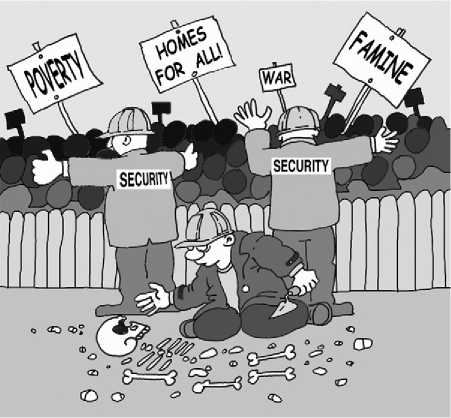A final theme within which archaeology is being given meaning in contemporary popular culture has only over the past few years gained in significance, as developer-funded rescue archaeology and cultural heritage and resource management have been thoroughly transforming the landscape of professionaL archaeology throughout the Western world. Archaeologists have become the Heritage Police.

Figure 4 The archaeologist taking care of ancient finds, cartoon by Quentin Drew.
This theme revolves around the notion that in managing ancient sites and finds, archaeologists bear the responsibility of taking care of what are scarce and nonrenewable resources. Accordingly, the archaeologist, whether a civil servant or an employee of a commercial company, is a caring specialist with limited time and limited resources who tries to salvage, for the benefit of society and humankind, valuable archaeological sites or artifacts - and the historical information they may possess - from decay or destruction (Figure 4). In addition, these professional rescuers, who are committed to working according to ethical principles, also fight things like tomb-raiding (it la Lara Croft) and the illicit antiquities trade.
Whereas the A theme is usually far-away archaeology, the C theme tends to be close-to-home archaeology. Whereas the former can be appreciated in national and indeed international media, the latter is particularly visible in local media such as newspapers. Local papers contain numerous reports about precisely what has been rescued where and which preserved archaeological sites or recovered finds exhibited in museums might draw visitors to the area. So strong is this fascination with caring for ancient sites and preserving historical evidence at risk that local rescue projects might even then be deemed newsworthy when nothing has been found: ‘‘No archaeological finds where National Road 29 will run’’ (Blekinge Ldns Tidning, 2 October 2002, my translation).
The C theme is now also entering the worlds of film and fiction. The well-known Swedish author P. C. Jersild published in 2003 a novel (De ondas kloster) about a small archaeological rescue firm struggling under various pressures as clues abouT the Medieval site under investigation emerge. Similarly, in the movie The Body (2001), the remains of none less than Christ come to light on a rescue dig in Jerusalem. The film archaeologist Dr Sharon Golban explains the circumstances of the discovery with the words: ‘‘They wanted to put up flats in about three months so we had to be quick.’’ The National Geographic Society, too, is now extending the appeal of their documentary films to include the C theme. A DVD of the 2002 production Inca Mummies: Secrets of a Lost Empire features on its cover not only some of the usual emblems of the A theme but also an invitation to ‘‘join archaeologists racing to rescue priceless Inca relics from looters and urban sprawl.’’
Although C and D themes are very compatible with each other and indeed often combined, the two are nevertheless not interchangeable. The archaeologist as specialist caretaker and manager of precious resources is not a detective carrying a notebook and a magnifying glass but rather a professional expert who wears either suit and tie or protective clothing suggested by the appropriate Health and Safety regulations.
Even science-fiction adventures, which are often featuring archaeologists, have now begun to reflect the real changes to the profession of archaeology on planet Earth. For example, the Startrek episode Q-less (1993) featuring rogue archaeologist Vash who has previously been expelled from the Federation’s Archaeology Council for selling illicit artifacts, contains a strong ethical message. When she is resuming her illegal activities, omnipotent alien Q informs the bridge crew of space station Deep Space Nine that Vash is ‘‘setting Federation ethics back two hundred years. Believe me, gang, she is far more dangerous to you than I am.’’
The C theme in archaeology has both comical and tragical elements. On the one hand, precisely why should anybody want to rescue a few ancient artifacts? On the other hand, the archaeologist can often not prevent but only alleviate the destruction of archaeological sites. In popular films like the Swedish comedy Den ofrivillige golfaren (1991), where a somewhat hopeless character played by Claes Mtinsson represents the state archaeologist Berglund, both elements are coming together. The audience smiles about the seemingly ridiculous endeavors of the naive and inept archaeologist but at the same time feels for this poor guy who is trying to do his important job, without being taken seriously by anybody.
The work of the caretaker archaeologist is usually appreciated by people. But when personal interests are involved, for example, when peoples’ personal beliefs, finances, or livelihoods are concerned, the stakes rise quickly and the archaeologist can be perceived as a formidable enemy. It may suddenly appear questionable why all this academic attention to ancient remains should be so sensible after all. For example, in the British film Pascali’s Island (1988), set on an Aegean island during the end of the Ottoman Empire, the local Pasha feels threatened by the archaeologist Anthony Bowles who lets it known that he will report his valuable discoveries to the national authorities in Constantinople so that the Sultan can take care of it in the proper way. The irony is that Bowles himself turns out to be a swindler who is seeking to get rich from the greedy Pasha.




 World History
World History









